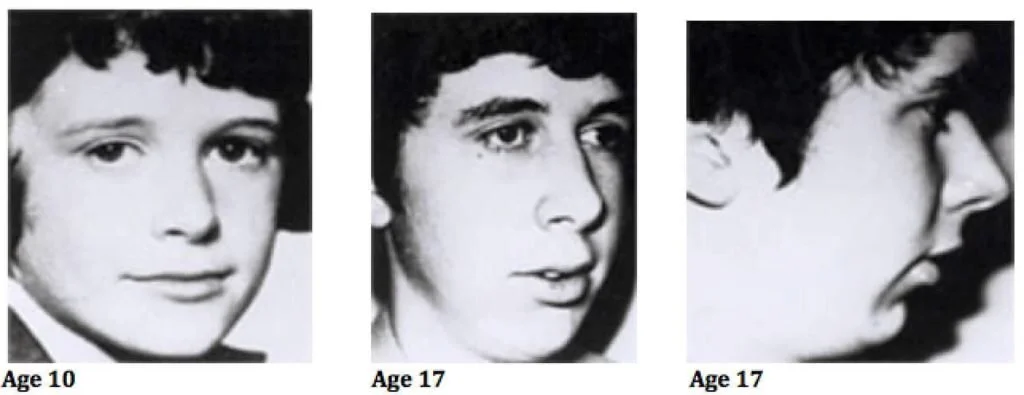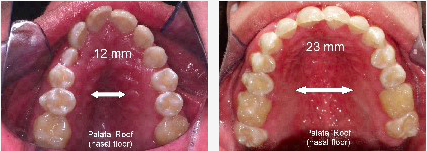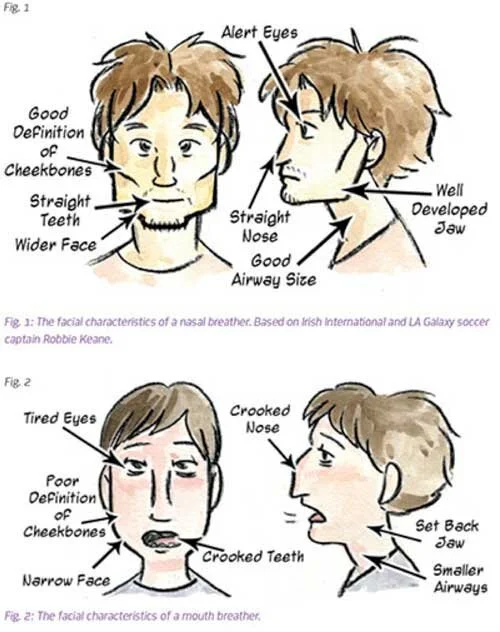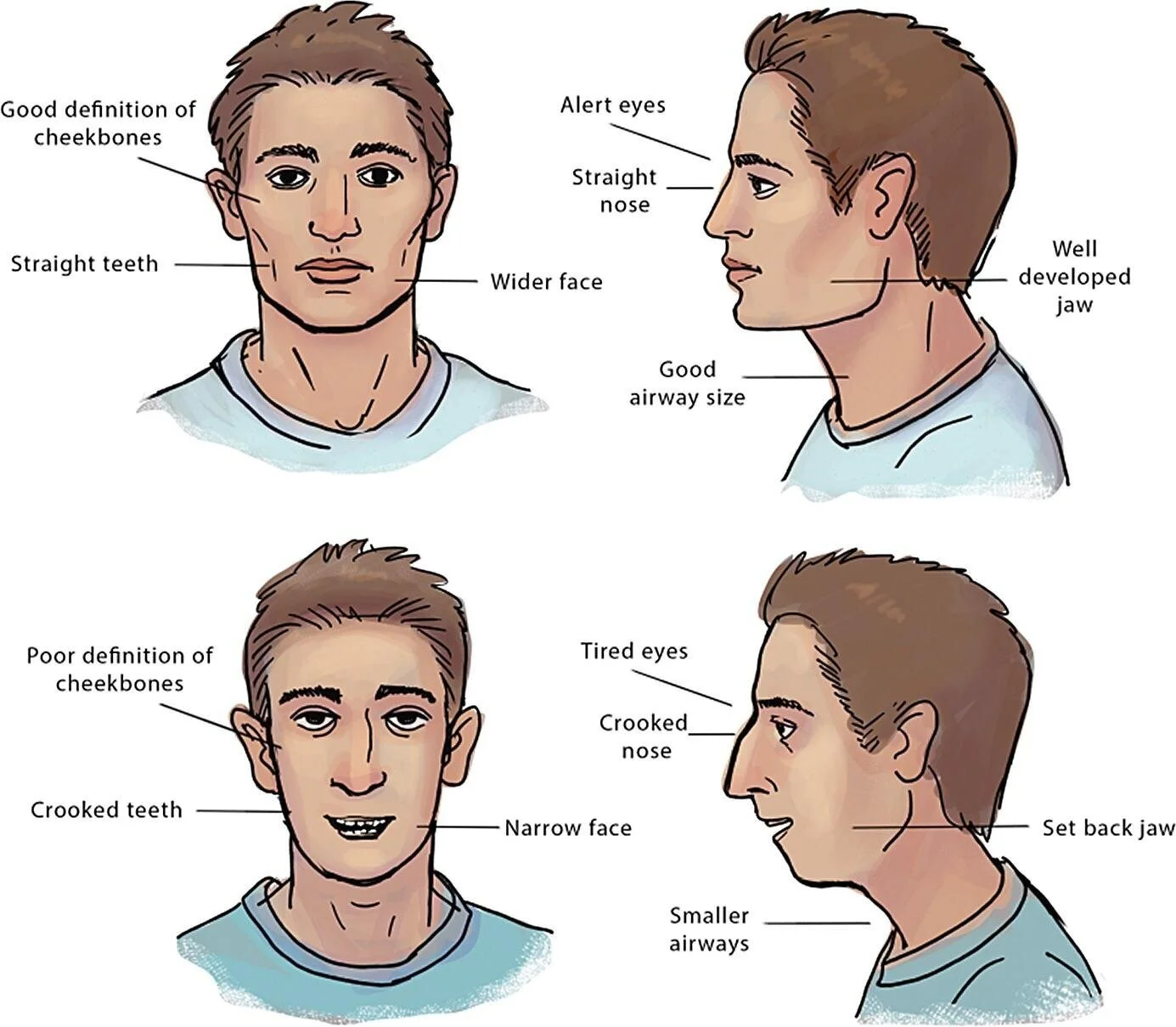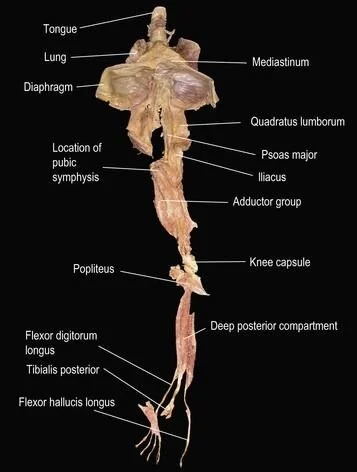Nose vs Mouth Breathing: Facial Development & and Mewing
Nose Breathing and Mouth Breathing: Impact on Facial Structure and Function
Nose breathing and mouth breathing significantly affect mental health, physical health, and performance. This article focuses on the influence each type of breathing has on facial appearance and function. To understand the development of your current oral posture and habits, it's essential to consider the habits formed in childhood.
It's Not All Genetics:
Contrary to popular belief, a significant part of your facial structure's development depends on whether you've been breathing through your nose or mouth throughout your life, as well as the nutrients consumed in childhood. Genetics play a lesser role in facial development during childhood and adolescence than commonly thought. Like body posture, facial structure is influenced by daily habits and activities. While genetics determine certain facial features like skin color, facial hair, ear size, eye color, and eyebrow shape, the overall structure is shaped by environmental stressors and long-term habits, especially during developmental years. This is explained by Wolff's law, which states that bones adapt to the loads they're subjected to. For example, postural abnormalities like scoliosis or kyphosis often result from repeated dysfunctional movement patterns, causing the body to structurally adapt to these as "default" positions.
Allergy at 12 years old leading to poor facial and airway development
Hormones Aren't the Main Factor:
Hormones, often blamed for facial differences between genders, play a less significant role than thought. Characteristics like high cheekbones and broad jawlines, associated with high testosterone, are not solely due to hormonal influences. Facial development is more closely linked to oral posture and the intake of vital nutrients (like fat-soluble vitamins D, K2, E, and A) crucial for bone strength and growth.
The Ever-Changing Body:
The human body is constantly changing. Even as adults, changes occur, albeit more slowly than in childhood. With the right knowledge, it's possible to improve facial and body posture, impacting appearance, health, and performance. The bones in the face, connected by sutures, are not fixed and can be influenced over time.
Narrow Palate = Narrow Airway , Wide Palate = Airway Expanded
The Link Between Breathing and Oral Posture:
Breathing through the nose is essential for 32 different body functions. It influences facial and cranial development from childhood into adulthood. Nose breathing encourages the mouth to stay shut, teeth to remain together, and the tongue to rest on the palate. These practices, known as "mewing," promote forward growth of facial bones like the maxilla and mandible, crucial for a non-restricted airway. Conversely, mouth breathing can lead to sleep apnea and other health risks.
Proper Dental and Facial Development
The Maxilla and Mandible:
Babies typically exhibit 'perfect' facial structures with forward growth, a result of natural nose breathing. Tongue pressure on the palate during childhood supports forward maxilla growth, shaping the face and teeth alignment. Adults with improper oral posture often have narrow, 'V'-shaped palates, leading to crowded teeth and other issues. Childhood habits significantly influence maxilla development.
The mandible's development is also crucial. Forward growth of the maxilla prompts the mandible to align properly, facilitating strong jaw muscles and proper facial development. Mouth breathing, however, can lead to a downward growth pattern, narrow jaws, receding chins, and poor body posture.
Nasal vs Mouth Breather Characteristics
Tongue Position:
Without proper tongue posture (resting on the roof of the mouth), the airway narrows, increasing health risks. The tongue, consisting of multiple muscles, is larger than it appears and extends down to the esophagus.
"Mewing" Recap:
Coined by Dr. John and Dr. Mike Mew, "mewing" refers to maintaining proper tongue and oral posture, crucial for facial development. It involves keeping the mouth shut, teeth together, and the tongue resting on the palate. Consistent practice of mewing can lead to gradual muscle and bone changes, improving facial appearance and posture.
Nose Breather vs Mouth Breather Characteristics
Deep Front Line:
Improper oral posture affects more than the face; it impacts body posture and core strength. Addressing these issues requires a holistic approach, considering the interconnectedness of facial and core muscles. Training systems like Functional Patterns offer integrative methods to improve overall biomechanics and quality of life.
Deep Front Line Fascia
In conclusion, the way we breathe, coupled with our childhood habits and nutrition, significantly shapes our facial structure. Understanding and applying principles of correct oral posture and nose breathing can lead to positive changes in facial aesthetics and general health. This underscores the importance of a holistic approach to health that considers the interplay between our habits, physical development, and overall well-being.
Nose vs Mouth Breathing
It may not come as a surprise but yes, the nose is designed for breathing.The average person breathes between 23,000 and 26,000 breaths...per day. You might think that it doesn't matter whether you breathe through the mouth or nose but as long we reach that number we'll be fine. Right? Wrong. The quality of each breath is so crucial that it determines whether you die early or not. Simply changing the way you breathe radically alters the way your mind and body function. Many people today are completely unaware of how they breathe and are never taught how to breathe properly. The health implications of this are immense when you consider that having incorrect breathing patterns greatly increases your risk for chronic disease, lowers your intelligence, and weakens you. You cannot have peak physical and mental performance without optimal breathing.
adventure-athlete-athletic-235922
Greater immunity
The nose plays a role in 30 different functions in the body. These functions are a product of the unique structure and anatomy of the nose and nasal cavity and are responsible for regulating not only the quantity and quality of our breathing but also how we deal with stress and thus the state of our health. Additionally, nose breathing assists in maintaining the balance of certain molecules and gases to achieve homeostasis in the body; as it is with the production and use of nitric oxide.Breathing through the nose allows for the bacteria and toxins in the air to be filtered and removed which plays a role in supporting our immune system. This happens because the nasal passages, adenoids, sinus, and mucous membranes have small hairs (villi) that trap the bacteria and prevent its passage into the body and bloodstream.Not only does nose breathing prevent bacteria from entering the body, but it also functions to optimize the quality of the air entering the lungs. Breathing through the nostrils increases the speed air enters the nasal cavity where then it is slowed down and processed. During this process, the nasal cavity produces nitric oxide which has various functions in the body but more specifically, boosting immune function.Bacteria in our environment use chemicals to communicate with each other. As air passes through the nose, nitric oxide is released (via the gene T2R38), which activates enzymes that react with these chemicals released from the bacteria. The benefit of this reaction is that the release of nitric oxide kills the bacteria in the nasal cavity before the air enters the lungs. Killing the harmful bacteria before it enters the body saves the immune system from overworking and protects the lungs. Nitric oxide also increases blood flow around the body as it acts as a vasodilator expanding the blood vessels thus, improving the delivery of oxygen to the muscles during exercise and allowing faster removal of carbon dioxide excess. By breathing through the mouth you miss these benefits.Let’s say we bypass these mechanisms and only breathe through the mouth? Instead of the air being filtered and prepared for the lungs, then it is the body’s second line of defence, the tonsils, will have to deal with bacteria. The repeated exposure to the bacteria in the environment increases rates of infection and decreases immunity. This bacteria is accumulating in the lungs, throat, and sinuses causing localized inflammation as the body’s immune system is constantly working overtime. Examples of what chronic mouth breathing and a lowered immunity can eventually lead to are: frequent tonsillitis infections, chronic mucous accumulation in the airways, sleep apnea, increased allergic reactions, chronic sinus and nose congestion, headaches, brain fog, and the list goes on…Aside from the systemic issues that occur from mouth breathing, there are structural changes that also occur to the airways, face and rest of the body. These changes will be discussed and described in a further post.
athlete-body-cinder-track-4078
Increased bloodflow and oxygen utilization
When we breathe through our nose, the diaphragm is activated and the air travels deeper into our lungs. It is deep in the lungs where a greater blood flow occurs due to the capillary and vein density which is needed for oxygen and carbon dioxide transfer (otherwise known as the ventilation/perfusion ratio). Breathing through the mouth activates the upper chest and lungs using the intercostal muscles more than the diaphragm. This decreases how much oxygen is absorbed as the upper part of the lungs has less blood flow. With the release of nitric oxide during nasal breathing, an additional benefit is that the molecule assists in raising the air from the lower part to the upper part of the lungs. The nitric oxide release increases the amount of oxygen absorbed as the entire capacity of the lungs is used rather than just certain segments like the upper lungs during mouth breathing.Lessbreath,no stress.How often are we told during moments of stress or fatigue that we should take large and deep breaths through the mouth to relax? This advice at first might make some sense as when you are stressed you can feel breathless and are unable to return to a relaxed state through pure willpower and attempts to alter your thoughts. Although, physiologically speaking, taking larger breaths when you’re already stressed makes no sense at all…As discussed earlier, breathing through the nose means breathing deeper into the lungs where there is more blood flow. It is also deep in the lungs where there is a greater percentage of parasympathetic ("rest and digest") nerves compared to the upper chest of sympathetic ("fight or flight") nerves. During nose breathing, the constraint of the nostrils on the quantity of air coming in and out of the lungs, as well as the moisture created, allows breathing to slow down and reach the lungs depth calming the body, as fast breathing is associated with stress. Because there is no limit to the amount of air coming in and out of the mouth, hyperventilation can occur as the oxygen inhaled is absorbed less efficiently than nose breathing, causing a larger craving for oxygen. Mental and physical stress in the body is increased as it is unnatural to be hyperventilating in a scenario where there are no external stressors occurring in the environment. Hyperventilating create higher than normal levels of the stress hormones adrenaline and cortisol to be released into the bloodstream. Chronically elevated levels of cortisol wreak havoc on many bodily processes. Over time people who chronically hyperventilate can have increased levels of anxiety, nervousness, and depression as the body is never truly relaxing and recovering.
The role of carbon dioxide
It is common to believe carbon dioxide (CO2) is a waste gas, but this is not the case. During nose breathing, there is an equal balance of CO2 and oxygen (O2) in the body. The difference between the two gases is that oxygen is stored in the body whereas carbon dioxide is not. Oxygen is primarily stored in the blood, wherein in a rested state, the blood oxygen saturation levels (blood stored in hemoglobin) is between 96 – 99% at all times. The use of this stored oxygen is for moments of exertion and stress when the body needs a rapid release and consistent supply for the working muscles. Although the oxygen stored can only be released if the body is producing a sufficient amount of carbon dioxide. It is for this reason that the main driver of respiration is changing levels of carbon dioxide, not oxygen. Changing levels of carbon dioxide are detected by various receptors (chemoreceptors) around the body, specifically in the neck, brain, and heart. These chemoreceptors are sensitive to the changes in pH in the blood. The pH of the blood directly indicates the level of carbon dioxide present because it has a low pH (acidic), whereas oxygen has a high pH (alkaline). Coming back to the importance of carbon dioxide’s role is respiration, we cannot forget about Christian Bohr, who discovered that this O2 stored in the hemoglobin is released as a backup when the CO2 levels in the blood increase (known as the ‘Bohr effect’). This happens because the acidic nature of CO2 directly has an effect on O2’s affinity to hemoglobin, making it easier for it to be split off and absorbed by the muscles. If insufficient carbon dioxide is present, less oxygen is released to be used by the working muscles. By nose breathing, you efficiently use this oxygen stored in the muscles as with the function of the nasal cavity of processing the breath and releasing nitric oxide, adequate levels of carbon dioxide are maintained and thus the ‘Bohr effect’ continues. By mouth breathing, less oxygen is available to be released by the hemoglobin because large amounts of carbon dioxide are exhaled creating a very high alkaline environment in the lungs. The body attempts to restore the lost CO2 by constricting blood vessels which decrease circulation and thus oxygen delivery around the body.
Cognitive performance
The quality and quantity of your breathing also have a correlation with your cognitive performance. Simply breathing through the mouth rather than the nose can decrease intelligence and impact the process of learning. Chronic mouth breathing throughout a child’s developmental phases seems to do the most long‐term damage as the body begins to adapt to the disuse of the nose for breathing. Not only physical changes but also psychological changes occur such as with this study where the authors concluded that mouth breathers have a higher incidence of learning disabilities compared to nose breathers. Why is this the case? Recent research into the effects of breathing on brain functioning highlights that people who breathe through their nose consolidate memories better than mouth breathers. The act of smelling also stimulates certain parts of the brain associated with memory such as the olfactory bulb which is linked with the amygdala and hippocampus. The sense of smell engages the prefrontal cortex which is essential in higher learning processes and thinking. In a way, mouth breathing seems to reduce the electrical activity of the areas of the brain active during nose breathing.
As part of the Nose vs Mouth breathing series:
Nose vs Mouth Breathing
Nose vs Mouth Breathing: Facial development & Mewing


